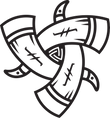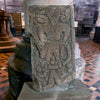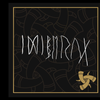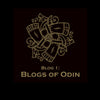The Loki Stone / The Bound Devil
- by Alyssa Nilsen

All photos © Daniel Farrand
In 1847, upon rebuilding Kirkby Steve parish church, an 8th-10th century carving was discovered in the fabric of the chancel.
The 1-meter-high carved stone looked like a section of a slab-like cross shaft, and its carvings differed from those found elsewhere in the church. On it was a man-like figure with broad shoulders and arms hanging down, palms out-spread, and a V-shaped incision below the chin, which may be a beard or the neckline of his clothing. His arms and legs are seemingly bound by rings. and on either side of his head were what looked like ram horns. But who could this be? Some suggest the devil - a logical leap considering the place where it was discovered. But some also suggest it could be Loki, the trickster god of Nordic Mythology. Or could it be both?
And why link this find to Loki and the Nordic sagas in the first place?

Several details about this stone point to the Nordic and mythology.
This figure style, the deformed men with large shoulders and hanging arms, is typical in Northumbria and Isle of Man Viking depictions. Cross shafts like these were used to help transition between Christianity and Nordic religions, show dominance, and cause doubt about the pagan gods.
There is a possibility that there was at one point an image of Christ as the all-powerful god above the bound figure, like on the Gosforth Cross - which we will cover in a separate blog post. On the Gosforth Cross, Thor is depicted fishing for Jormungandr but failing to kill the beast. Above Thor is an image of Christ standing on the serpent in a show of power: The Christian god triumphs over the old pagan gods.

In the carving, the figure’s arms and legs are bound by rings; between the legs, there seems to be an anchorage point for the bindings. Ring and bar bindings like this have a history in Scandinavian art, and we know the stone is from the Viking Age and has apparent similarities to other Nordic carvings of Loki, like the carved memorial stone on the Baltic island of Gotland.
So, if we conclude that the depiction on the stone IS Loki, what story is it from?
The Binding of Loki is one of the more famous stories from the Sagas.

Loki, upon fleeing from the wrath of the other gods having caused Baldr’s death, was caught by Thor whilst hiding in the shape of a fish. Loki was then taken, in his regular form, to a cave. The gods then brought in Loki’s two sons, turning one into a wolf, who promptly killed his brother.
Loki was then fastened to three rocks in the cave with the entrails of his slain son, which the gods had turned into iron chains. Skadi placed a poisonous snake on a rock above his head, dripping venom onto his face. But Loki’s faithful wife, Sigyn, sat by his side with a bowl she held up to the snake’s mouth to catch the poison. But every so often, the bowl became full, and Sigyn would have to leave her husband’s side to dispose of its contents, at which point the drops that fell onto the unrepentant god’s face would cause him to shake violently, which brought about earthquakes in Midgard, the world of humanity. And this is the lot of Loki and Sigyn until, as fated, Loki will break free from his chains at Ragnarok to assist the giants in destroying the cosmos.
At the time, Loki had also become one of the Christian symbols of the devil in human shape, a northern concept spread over Europe by Scandinavian settlements.
At the end of the day, all we have thus far is theories.
But both the carvings and the theories of their meaning paint a fascinating story of the transition between pagan and Christian gods both in the Nordics and the British Isles.



